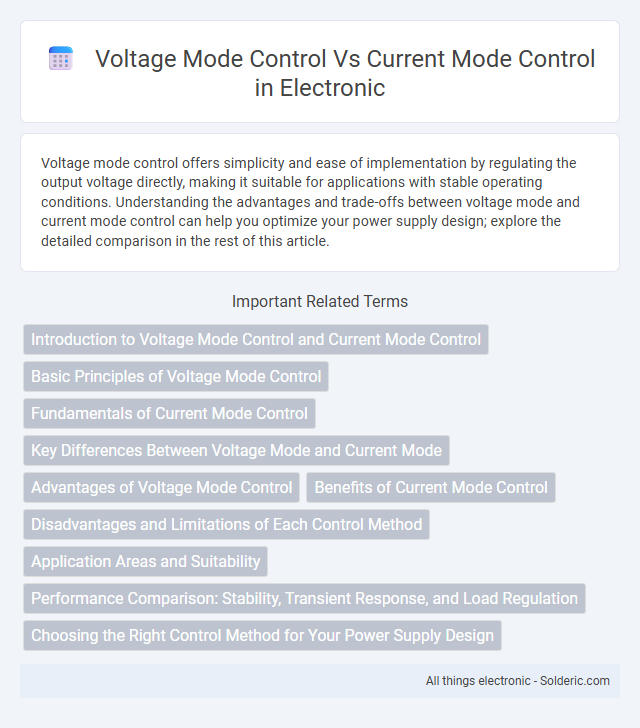Voltage mode control offers simplicity and ease of implementation by regulating the output voltage directly, making it suitable for applications with stable operating conditions. Understanding the advantages and trade-offs between voltage mode and current mode control can help you optimize your power supply design; explore the detailed comparison in the rest of this article.
Comparison Table
| Feature | Voltage Mode Control | Current Mode Control |
|---|---|---|
| Control Variable | Output voltage | Inductor current |
| Loop Complexity | Single loop | Dual loop (current + voltage) |
| Response Time | Slower transient response | Faster transient response |
| Stability | Needs compensation for subharmonic oscillations | Inherently stable with slope compensation |
| Output Ripple | Higher output voltage ripple | Lower output voltage ripple |
| Implementation | Simple and cost-effective | More complex, higher component count |
| Applications | Low-cost DC-DC converters, simple power supplies | High-performance DC-DC converters, fast load changes |
Introduction to Voltage Mode Control and Current Mode Control
Voltage Mode Control regulates the output voltage by adjusting the duty cycle of the power converter, using the error between the desired and actual voltage to maintain stable output. Current Mode Control enhances regulation by directly controlling the inductor current, offering faster response and improved protection against overcurrent conditions. Understanding these control strategies helps you optimize power supply performance for various applications.
Basic Principles of Voltage Mode Control
Voltage mode control regulates the output voltage by adjusting the duty cycle of the pulse width modulation (PWM) signal based on the error between the reference voltage and the actual output voltage. This method uses a single feedback loop that senses the output voltage and compares it to the desired setpoint, driving the pulse width modulator to maintain a stable voltage level. The simplicity of voltage mode control enables straightforward implementation but may require compensation networks to ensure stability and dynamic response under varying load conditions.
Fundamentals of Current Mode Control
Current Mode Control fundamentally regulates the inductor current directly by comparing it to a reference current, enhancing system response and stability in switch-mode power supplies. This method inherently provides cycle-by-cycle current limiting and simplifies the control loop by effectively converting the power stage into a single-pole system. By sensing and controlling the inductor current, Current Mode Control improves transient response and reduces the need for complex compensation compared to Voltage Mode Control.
Key Differences Between Voltage Mode and Current Mode
Voltage mode control regulates the output voltage by adjusting the duty cycle based on the error between the reference and actual output voltage, while current mode control directly regulates the inductor current to provide faster response and inherent overcurrent protection. Voltage mode control features a single feedback loop and requires compensation to stabilize the system, whereas current mode control uses dual feedback loops--voltage and current--simplifying compensation and improving dynamic performance. Current mode control offers better line and load regulation due to its current feedback, making it more robust in transient conditions compared to voltage mode control.
Advantages of Voltage Mode Control
Voltage Mode Control offers simpler implementation and easier loop compensation compared to Current Mode Control. It provides a straightforward PWM signal generation, making it suitable for applications with a stable input voltage and load conditions. This control method enhances noise immunity and reduces the risk of subharmonic oscillations in power converters.
Benefits of Current Mode Control
Current mode control offers improved system stability by providing inherent overcurrent protection and faster response to load changes. It simplifies the feedback loop by directly controlling the peak inductor current, resulting in better transient performance and reduced output voltage ripple. Your power supply design can achieve enhanced accuracy and reliability with current mode control compared to traditional voltage mode control.
Disadvantages and Limitations of Each Control Method
Voltage mode control faces challenges such as poor performance under load variations and increased susceptibility to noise, which can cause instability in your power supply system. Current mode control, while improving response and stability, suffers from issues like subharmonic oscillations at duty cycles above 50% and increased complexity in implementation. Both methods have limitations in bandwidth and transient response, requiring careful consideration based on specific application needs.
Application Areas and Suitability
Voltage mode control is ideal for applications requiring simple design and stable output voltage, such as low-power DC-DC converters and LED drivers. Current mode control is more suitable for high-performance systems demanding fast transient response and precise current regulation, including switching power supplies and motor drives. Your choice depends on factors like load dynamics, noise immunity, and system complexity.
Performance Comparison: Stability, Transient Response, and Load Regulation
Voltage mode control offers simpler implementation but is more susceptible to instability under varying load conditions and slower transient response compared to current mode control. Current mode control enhances stability by providing inherent overcurrent protection and faster transient response due to direct current feedback, resulting in improved load regulation and minimized voltage deviations. In high-performance power converters, current mode control is preferred for superior dynamic behavior and tighter regulation across diverse load conditions.
Choosing the Right Control Method for Your Power Supply Design
Voltage mode control offers simplicity and stable voltage regulation, making it ideal for designs where load variations are predictable. Current mode control enhances response to load changes and provides built-in overcurrent protection, improving system stability in complex or variable load conditions. Assess your power supply's load dynamics and protection requirements to determine whether voltage mode or current mode control best suits Your design goals.
voltage mode control vs current mode control Infographic

 solderic.com
solderic.com